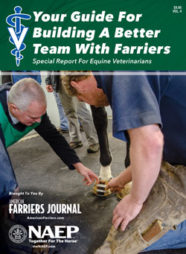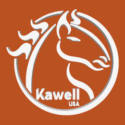Some farrier businesses fail because the operators have little or no understanding of business.
According to the United States Small Business Administration, two-thirds of all new businesses survive at least 2 years, but only half of those are still around at 4 years. If you don’t want to become one of these negative statistics, you need to work on your business as well as in your business.
Profits And The Bottom Line
To be successful in business you need to change your attitude about yourself and your business. You need to stop being so protective of your customers’ pocketbooks and start meeting your own economic needs and those of your family. There are three main ways to increase your profits:
- Invest.
- Increase prices.
- Decrease expenses.
This article will focus on increasing profits by looking at how to charge for hoof-care services.
Some of the pitfalls in trying to increase your profits are:
- Charging different prices for the same service.
- Discounting services regularly.
- Not making regular price increases.
- Worrying too much about potential customer losses.
- Undercharging for your services.
- Obtaining and maintaining customers by setting the lowest prices in your area.
- Rating your customers by an A-B-C method instead of by percentage of profit margin.
- Working harder instead of smarter.
One of the most frequent questions I hear from farriers — whether established farriers, novices or those who are new to an area — is, “How much should I charge?” That’s closely followed by, “Am I charging enough?” Many shoers charge what the average farrier in their area is charging or adjust their charges downward, based on their own misperceived value.
Some farriers even undercut local farriers by charging the lowest prices in the area. None of these methods will increase your profits in a healthy manner. What you need to do is learn how to do three things:
- Determine what to charge.
- Evaluate whether or not you are charging enough.
- Schedule regular price increases.
Practical Price Setting
So how do you go about correctly setting effective prices? Some solutions can be overwhelming and complicated. Experienced business people use spreadsheets and in-depth software programs. For many farriers, this can be too complicated and time consuming.
A simpler way of knowing how much you need to charge is the General Business Profit and Loss Method or simply the “working backward method.”
This method works on the principle of how much you want to earn per hour, per week or per year. See the four steps to apply this method to your practice.
Based in Webster, N.Y., Esco Buff is a member of the International Horseshoeing Hall Of Fame. He holds a Ph.D. in business administration.
Step 1: How Much Money Do You Want?
Determine how much money you want to net each month.
Most small businesses have expenses ranging from 30% to 50%, profits from 10% to 50% and pay 15% to 45% in taxes.
A general rule of thumb is to figure that a third of your gross goes toward taxes, a third toward expenses and the remaining third is profit. To be more precise, use the net business income profit ratio (the ratio of net profits to total sales), which generally will translate into around 40% of your gross sales as profit.
Example
Let’s say you want $1,500 a month or $18,000 a year. Remember, you owe taxes on your net. Multiply your net by 1.1807 to obtain the net before taxes. $1,500 x 1.1807 = $1,771 a month ($21,252 a year).
Continuing, now multiply your net by 2.5 to calculate your gross. $1,771 x 2.5 = $4,427 a month ($53,130 a year).
Now you have determined how much money you need to gross (total sales) to obtain your desired net.
Step 2: How Hard Do You Want To Work?
Determine how hard you want to work to earn that gross. How many weeks a year do you want to work? Lets say 48 weeks (give yourself 4 weeks of vacation and holidays). To determine how much money you need to make in a week, divide your gross by the number of weeks worked.
To break even with the minimum wage, you need to net around $17,125 (working 40 hours a week for 48 weeks a year). Are you doing this? More importantly, does this adequately provide for your family?
If not, making the decision not to raise your prices means you are working at a less-than-minimum-wage job that doesn’t meet your economic needs. Farrier work is hard enough. Operating a business at a continual loss makes little sense.
Example
$53,130 divided by 48 = $1,107 a week ($221 a day). This works out to $28 an hour for an 8-hour day.
So are you making $221 a day? If not, then you need to either lower the amount you want to net or increase your prices.
Step 3: What Are Your Labor Ratios?
You are setting up the estimated flat rate based on correct labor ratios, which include down time or in our case, travel time.
How much do you need to charge your customers? In service industries that depend more on labor than parts, common procedures are: to bill by the hour; by estimates of the normal time to do a job; or charge a flat rate for a particular service.
If you charge by the hour, you will fall short of your desired net because you have not taken into account the lag time between customers. For farriers, it probably works best to charge a flat rate for a particular type of job, based on the average amount of time it takes you.
Example
Let‘s use 20 minutes. How many trims can you reasonably do in a day, including travel time? Five? Seven? 10? If you need to gross $221 a day, and you estimate five trims, you need to charge $44.20 per horse ($221 divided by 5). If you can do seven trims, you need to charge $31.57 per horse. If you can do 10, that’s $22.10 per horse.
Step 4: What Are Your Work-To-Price Ratios?
Ensure your work-to-price ratios are correct. For instance, if trimming one shoe takes you 20 minutes, then two shoes should take you about 40 minutes, and four shoes about an hour.
If you don’t have these ratios calculated correctly, you may actually be losing money for shoeing a horse.
Example
If you charge $40 to trim a horse, you net $16 (gross x 0.4 = net or $40 x 0.4 = $16). If you charge $65 to apply two shoes, you net $26.
You were paid more money, but you actually netted $6 less than you needed for the time involved. If you had charged $80, then you would have netted $32 ($80 x 0.4). That’s the ratio you want; a 20-minute trim for a profit of $16 and a 40-minute shoeing job for a profit of $32.
The gross daily net is based upon how much you need to make in a day. If it takes you longer to make that amount, you need to either increase your prices or lower the amount you want to make.
Essentially, you have to figure your price based on a charge per minute.







